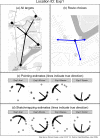Route effects in city-based survey knowledge estimates
- PMID: 36689073
- PMCID: PMC10110726
- DOI: 10.1007/s10339-022-01122-0
Route effects in city-based survey knowledge estimates
Abstract
When studying wayfinding in urban environments, researchers are often interested in obtaining measures of participants' survey knowledge, i.e., their estimate of distant locations relative to other places. Previous work showed that distance estimations are consistently biased when no direct route is available to the queried target or when participants follow a detour. Here we investigated whether a corresponding bias is manifested in two other popular measures of survey knowledge: a pointing task and a sketchmapping task. The aim of this study was to investigate whether there is a systematic bias in pointing/sketchmapping performance associated with the preferred route choice in an applied urban setting. The results were mixed. We found moderate evidence for the presence of a systematic bias, but only for a subset of urban locations. When two plausible routes to the target were available, survey knowledge estimates were significantly biased in the direction of the route chosen by the participant. When only one plausible route was available, we did not find a statistically significant pattern. The results may have methodological implications for spatial cognition studies in applied urban settings that might be obtaining systematically biased survey knowledge estimates at some urban locations. Researchers should be aware that the choice of urban locations from which pointing and sketchmapping are performed might systematically distort the results, in particular when two plausible but diverging routes to the target are visible from the location.
Keywords: Direction estimation; Pointing task; Sketch maps; Survey knowledge; Urban environments.
© 2023. The Author(s).
Conflict of interest statement
The authors declare no conflicts of interest.
Figures













References
-
- Aust F, Barth M (2022) Papaja: prepare reproducible APA journal articles with R Markdown (Version 0.2.0). https://github.com/crsh/papaja (Original work published 2014)
-
- Bürkner P-C. Brms: an R package for Bayesian multilevel models using stan. J Stat Softw. 2017;80:1–28. doi: 10.18637/jss.v080.i01. - DOI
MeSH terms
Grants and funding
LinkOut - more resources
Full Text Sources

